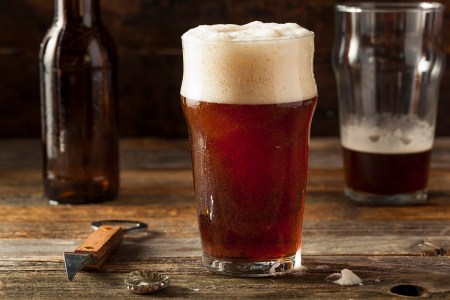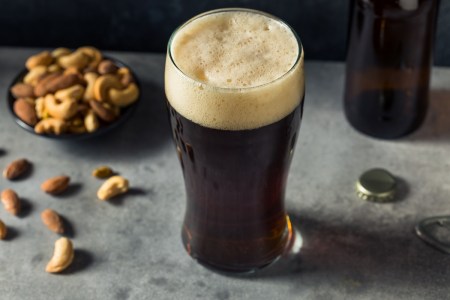
As the cooler months settle in, many drinkers are turning to darker ales and lagers to warm the cockles of their hearts. A beautifully rich brown ale has to be one of my favourite beers – at any time of the year! Join me as we get into some fudgey, dark chocolatey, caramely goodness!
Find our other Recipe of the week articles here.
Cast your minds back to Old Blighty around the 1800s. London was a very dark and gloomy place and there was a style of beer emerging that was becoming quite popular. Moving away from the pale ales and IPAs, a brown ale was gaining popularity and was mostly known back then as a “mild”. This may have been due to the fact that darker roasted malts were not only easier to get a hold of, but also cheaper, so many of the early milds or brown ales would have been brewed with 100 per cent brown malt.
Later, as malting became more precise and efficient, pale and ale malts were used as the base malt with a smaller amount of darker malts added to the grist to achieve the same brown ale properties. This mild ale later became known as a brown ale, and, like many other styles, has changed and morphed into an entirely different style of beer than its original self.
I do remember working in a pub in the UK, where Davey boy would insist I keep his bottles of mild next to the fan of the chiller – which as you may or may not know blows out warm air. If they were not warm, he would abuse me – in a friendly barkeeper kind of way!
Brown is the new brown
When we start looking at brown ale, we also have to consider where they came from and where they went. As the popularity of the term brown ale caught on, the term mild was not so common any more. The low ABV ale soon became more robust, more bitter and, in the case of our US cousins, quite a bit more hop forward.
With evolution it could be said that the original brown ale doesn’t really exist any more. So when does a brown ale not become a brown ale?!
The original mild or brown ales were relatively low ABV ales – around the 2.8 to 3.4 per cent mark with low levels of bitterness – so they were very common among the working class. Not many of these brown ales exist any more.
Of course brown ales and milds were brewed in a great many breweries and one of my absolute favourites is a Belhaven 60/- (shilling) ale. These were all very much malt-dominant beers.
Mann’s Brown Ale revived the old style of ale and marketed theirs with great success in the early 1900s. A few decades later the world famous Newcastle Brown was introduced.
“Newkie Brown” is a sweet, malty beer that’s wonderfully rich and not too roasty. This beer really made brown ales popular again and gained global recognition.

The Pope of foam
I got in touch with Professor Charlie Bamforth (pictured) to get his views on mild – a beer close to his heart.
“Mild ale is perceived as a drink for oldies (like me I guess!). That’s such a shame, because it is a style that can be beautifully rounded and drinkable. It is very much to do with the malt and not the hops.
“When I think about mild these days I have in mind a pronounced toffee, nutty richness coming from caramelised malts and not too much alcohol but superbly drinkable.
“Of course, the original milds were simply the young beers from a brewery and not necessarily darker ones. On my first undergraduate day at University in 1970 my lunch was a bag of crisps and a pint of Mitchell & Butlers Mild – a beer from the Black Country in the English West Midlands of course.
“Workers way back when in the steel foundries thereabouts used to have mild ale brought into the factories: it was rehydrating, easy on the parched throat and nutritious.
“My personal favourite is Banks’ Mild (pronounced “Bonksies”) from Wolverhampton (home of my beloved Wanderers). Just 3.5% ABV but simply succulent. In these days, when so many are shooting for ever higher ABV and also bigger and bigger hoppiness, there is much to be said for a mild ale like this one to illustrate the beauty that can be had from malt. High time for a lot of folks to get retro and discover the tremendous potential of mild ales in the lower alcohol sector.”
Brew day
Today we’re going to brew a Scottish Mild – in fact a 60/- (shilling) ale. Beautiful rich toffee, caramel and malt tones should dominate this beer with a low to moderate hop bitterness with a bittersweet, dry finish.
This is my version of a Belhaven 60/- ale, so go on and get yae kilt on and crack intae it. If you can get some Golden Promise malt, substitute that for the Pale. Getting your water right is going to be crucial so look for an Edinburgh water profile. Get a good quality Scottish Ale yeast and ferment at 16°C.

The Scottish Mild Belhaven 60/- Clone Recipe
All grain recipe (expected figures)
OG: 1.034
FG: 1.006
ABV: 3.7%
IBU: 21
Volume: 19 litres
Ingredients
2.3kg Pale malt
50g Light/med crystal malt
50g Black Malt
31g East Kent Goldings hop pellets
6g Fuggles hop pellets
Whirlfloc tablet (optional)
Scottish Ale Yeast (Wyeast 1728 or similar)
Method
- Mash all grains at 67°C for 60 minutes.
- Sparge and transfer to kettle, and bring to boil.
- Once boiling add 25g EKG hops for a 90 minute boil.
- With 10 minutes left on the boil, add 6g of EKG hops, 6g Fuggles hops, and whirlfloc if using.
- Transfer to the fermenter and cool to 16°C, then pitch yeast.
- Maintain ferment temp at 16°C.
- Once FG stabilises, keg or bottle conditioning for 4 weeks minimum. Slainthe!
Extract with specialty grains recipe (expected figures)
OG: 1.034
FG: 1.006
ABV: 3.7%
IBU: 21
Volume: 19 litres
Ingredients
1.9kg Pale malt extract
50g Light/med crystal malt
50g Black Malt
31g East Kent Goldings hop pellets
6g Fuggles hop pellets
Whirlfloc tablet (optional)
Scottish Ale Yeast (Wyeast 1728 or similar)
Method
- Steep cracked grains in 5 litres of 67°C water for 60 minutes, then drain.
- Slowly dissolve the extract in 3 or 4 litres of warm water along with the 5 litres of wort from mini mash whilst bringing to the boil.
- Once boiling add 25g EKG hops for a 90 minute boil.
- With 10 minutes left on the boil, add 6g of EKG hops, 6g Fuggles hops, and whirlfloc if using.
- Add fresh clean and cool water to a volume of 20 litres at 16°C.
- Check the temperature then pitch yeast.
- Maintain ferment temp at 16°C.
- Once FG stabilises, keg or bottle condition for 4 weeks minimum. Slainthe!
This recipe appeared in a previous issue of Beer & Brewer. To access multiple recipes every issue, from pros and homebrewers alike, subscribe to our magazine here.

